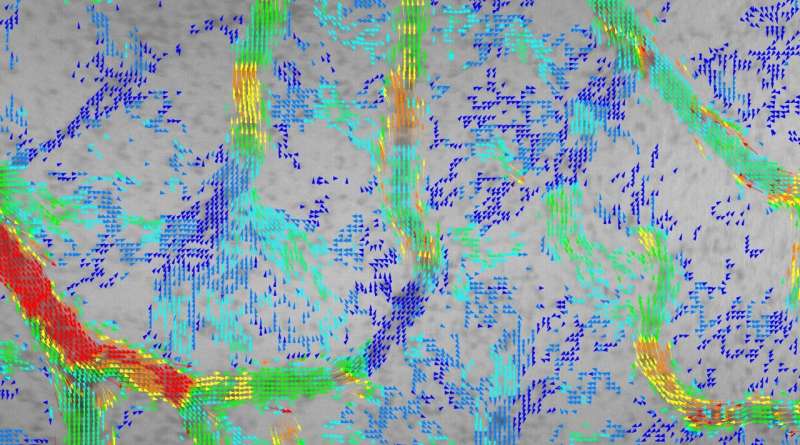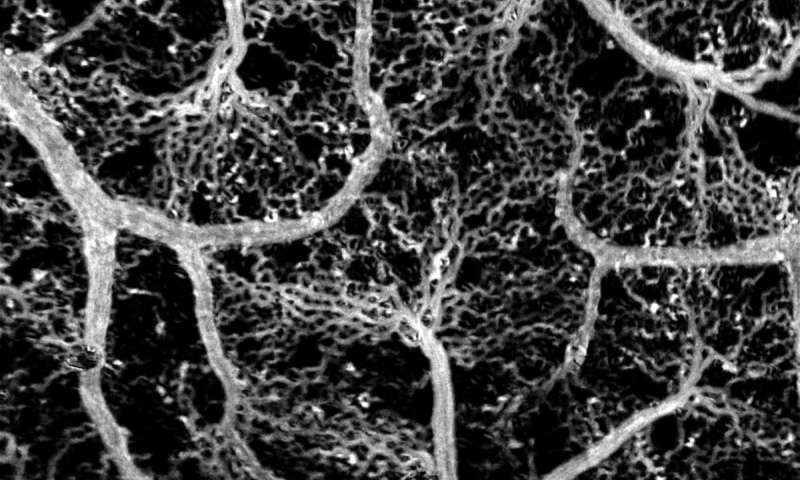
Researchers from the Skolkovo Institute of Science and Technology and Saratov State University have come up with an inexpensive method for visualizing blood flow in the brain. The new technique is so precise it discerns the motions of individual red blood cells—all without the use of toxic dyeing agents or expensive genetic engineering. The study was published in The European Physical Journal Plus.
To understand more about how the brain’s blood supply works, researchers map its blood vessel networks. The resulting visualizations can rely on a variety of methods. One highly precise technique involves injecting fluorescent dyes into the blood flow and detecting the infrared light they emit. The problem with dyes is they are toxic and also may distort mapping results by affecting the vessels. Alternatively, researchers employ genetically modified animals, whose interior lining of blood vessels is engineered to give off light with no foreign substances involved. Both methods are very expensive, though.
Researchers from Skoltech and Saratov State University have devised an inexpensive method for visualizing even the smallest capillaries in the brain. The method—which integrates optical microscopy and image processing—is dye-free and very fine-grained, owing to its ability to detect each and every red blood cell traveling along a blood vessel. Since the number of RBCs in capillaries is not that high, every cell counts, so this is an important advantage over other methods, including dye-free ones.
“Our method uses what’s known as frame-by-frame filtering to process brain images obtained with an ordinary optical microscope available at any lab. It allows us to discern single moving red blood cells and build a highly detailed map of the vasculature [blood vessel network], down to the smallest capillaries. This in turn makes it possible to accurately assess blood flow rates in the vessels via a technique called particle image velocimetry,” says the study’s lead author, Skoltech research scientist Maxim Kurochkin.
The team showed the method’s applicability using two biological models: the mouse brain and the chicken embryo. First the researchers used the vascular networks of the chicken embryo to demonstrate the possibility of mapping even the tiniest capillaries, in which RBC motions may be inconstant. After that, they tested the method on a more complex model: rat brain vasculature. The technique proved capable of mapping blood vessel networks even for a system with vessels that are harder to reach, with no individual RBCs discernible, only the color patterns associated with groups of vessels.

Why is mapping blood flow important?
The characteristics directly provided by the method are blood flow rate and vessel diameter. “But once you have that, you can try and extract more information: vessel elasticity, membrane stiffness, blood pressure and viscosity,” Kurochkin explains. “Physiologists building on our work can use these parameters to create blood circulation models, testable against experimental measurements from pressure and viscosity sensors, for example.”
Ultimately, this all leads to a better understanding of the physiology of endothelial cells, which line the interior of all blood vessels. And the state of the endothelium is tied to virtually all cardiovascular diseases, which are the leading cause of death globally. In effect you’re getting an understanding of what actually physically constitutes any given pathology, be it in the brain or elsewhere in the body.
A hemorrhagic stroke, for example, happens due to blood vessel thinning and rupture in the brain. Specifically, when a weak spot in a vessel wall balloons into what’s known as an aneurysm. “An accurate vasculature model could tell you just how much thinning of a vessel’s wall causes it to break,” Kurochkin says.
Coronary heart disease results from a reduction of blood flow due to fatty plaques building up on the inner walls of the arterial vessels, reducing their effective diameter. In a heart attack, a ripped off plaque obstructs the vessel, cutting off the blood supply. “Vasculature models predict how vessel dilation, constriction, or obstruction redistributes the blood flow in the network,” the researcher adds.
Blood vessel health is indirectly involved in diseases of different nature, too. For example, the new visualization method could be applied to study tumors, which consume abnormally high amounts of nutrients and therefore tend to develop a lot of blood vessels. A further example, from among infectious diseases, is malaria, in which blood viscosity becomes elevated. Besides that, even the consequences of mechanical damage—for example in medical punctures—could be studied within the same general approach to see how punctured tissue regrows blood vessels.
Source: Read Full Article
